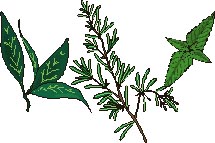| Herbs should never be grown without following organic techniques. Organic gardening is much more than merely a method of growing plants. It's a way of life. It's about paying attention to nature. It's about understanding how everything in nature is related. It's about learning from nature and working within nature's perfectly designed system. From the gardening standpoint it is also about using herbs that aren't contaminated with toxic chemicals.
 Herbs as a group are relatively easy to grow. Begin your herb garden with the herbs you enjoy using the most. For example, choose Basil, Oregano, and Fennel for Italian cooking; Lavender and Lemon Verbena for making potpourri; or Chamomile, Peppermint, and Mint if you plan to make your own teas. The best growing conditions vary with different herbs. Some of the herbs familiar to all of us, such as Lavender, Rosemary, Thyme, Marjoram, Dill, and Oregano are native to the Mediterranean region. These herbs grow best in soils with excellent drainage, bright sun, and moderate temperatures. Herbs as a group are relatively easy to grow. Begin your herb garden with the herbs you enjoy using the most. For example, choose Basil, Oregano, and Fennel for Italian cooking; Lavender and Lemon Verbena for making potpourri; or Chamomile, Peppermint, and Mint if you plan to make your own teas. The best growing conditions vary with different herbs. Some of the herbs familiar to all of us, such as Lavender, Rosemary, Thyme, Marjoram, Dill, and Oregano are native to the Mediterranean region. These herbs grow best in soils with excellent drainage, bright sun, and moderate temperatures.
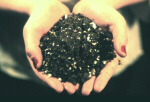 Soil Soil
Most herbs want fairly fertile, well-drained soil. Average garden soil is fine; you can add plenty of compost, well-rotted manure, and leaves, and other organic material. Add your leaves and manure in the autumn so they have a chance to break down and release nutrients; dig compost or old well-rotted manure into the soil in the Spring. You can also top-dress with compost once your plants have emerged. Never use anything other than organic fertilizers; chemicals will be taken up by your plants, which means you cannot use them in the kitchen. Once your plants are established, you can use mulch to help keep moisture from evaporating. Put down a layer of bark mulch, or even a layer of small stone chippings.
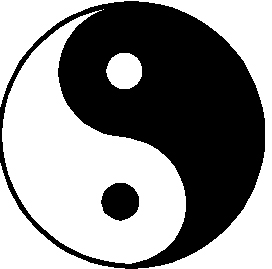 Light - Sun or Shade? Light - Sun or Shade?
While most herbs are happiest in a sunny location, don't think that because your site is shaded you can grow nothing! Many herbs will flourish in a partly shaded location, and some even prefer shade! Herbs like Chamomile, Dill, Parsley, and Mint will grow happily in light shade.
 Annuals or Perrenials ? Annuals or Perrenials ?
This refers to how long the plant lives. Annuals live for only one year; they must grow, flower, and produce seed all in one year. Some common annuals are: basil, coriander and summer savory.
Perennials live for many years, producing flowers and seeds each year, although often a perennial will not flower in its first year. Perennials need to be dug up and "divided" every few years; that is, gently break apart the root clumps into several smaller plants. Some common perennial herbs are: thyme, mint, sage, and chives. Some perennials are not hardy, and so they are grown as annuals. These are called tender perennials and include rosemary and aloe.
 Hardiness Hardiness
If a perennial is hardy in your area that means it will survive the winter. It may go dormant and look dead, or it may be an evergreen, but it will come back in the spring. If a perennial is not hardy in your area, you should expect either to get only one growing season from it (called growing as an annual) or to bring it indoors over the winter. Hardy annuals can be planted out early in the spring and will generally survive the first few frosts of autumn; tender annuals need to be planted after all danger of frost is past, and will be killed by the first autumn frost.
 Planting your Seeds Planting your Seeds
Most herbs can be successfully started from seed, whether you start them indoors under lights or outside. Some, however, like parsley and dill do not like transplanting and should be sown where they are to grow. To start seeds indoors, you will need containers of some sort--small pots, plastic trays like the nurseries use, or even the plastic containers that most supermarkets use for their vegetables now. You will need a growing medium--most garden supply places will sell you a seed growing compost, do not use soil as it may contain diseases. You will need labels so that you don't forget what you have sown and where! Fill the pots or trays about 3/4 of the way up. Plant seeds in clusters of 3 if you're using pots, or in rows about 2 inches apart if you're using trays. Cover them with a layer of compost about 2 to 3 times the diameter of the seed. Some seeds do need light to germinate and should not be covered. Most packets of seed carry detailed instructions on how to sow and plant on the back of the packet. If you follow these you will generally be successful. You must grow your seeds with as much light as possible as growing in a dark place will mean that you will have weak, skinny seedlings, which will easily get diseased.
To start your seeds outdoors, prepare your seedbed ahead of time. Dig it thoroughly and make sure it is weed free, then rake it smooth, breaking up any clods. Scatter the seeds and cover them with a small amount of fine soil. Be sure to keep the seedbed moist as the seeds are germinating and the young seedlings growing. You will need to thin these down to the strongest as well. Keep the bed weed-free.
 Feeding Feeding
Use organic mulch, preferably from your own garden. I strongly recommend that chemical fertilizers are not used. However, nitrogenous fertilizers may be applied to rejuvenate plants after they have been cut back.
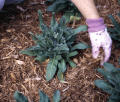 Weed Control Weed Control
Don't let weeds seed "1 years seeding means 7 years weeding" as my mother used to say. I recommend manual weeding, not chemical. Once a plant is established there may be little need for further weeding. For faster ground cover, I recommend high density planting.
There are only two sorts of weed - those that are easy to kill and those that are damned hard.
It is better not to pull up weeds amongs established plants as this can disturb their root systems. Digging up the weed's roots could equally damage the roots of your herbs. Rather than trying to remove the whole weed it is perhaps easier to remove the top growth regularly. This weakens the plant and eventually it will give up the ghost. You need to remove each leaf before it has unfurled enough to provide sustenance to the weed, in this way the root system becomes exhausted and the weed will give up, but you need to be persistent.
When to Weed
Try to weed in bright light, when you can see clearly. However, weeding when you can is better than weeding too late!
Small weeds hoed down can be left in dry conditions, they disappear into the soil as natural compost. However, in wetter conditions or larger ones and the weeds may re-root or even seed where they lie, so it is better to collect them for composting. All weeds, even seeding ones, can be composted, but the more pernicious ones such as bind-weed or couch grass are best left to wither in the sun for a few days beforehand. Hand weeding This is necessary amongst established plants. Make it easier with a sharp, long-bladed knife to cut the weeds away from their roots.
Hoeing
The quickest and most effective way of keeping bare soil clear. A hoe has a blade on a long handle and you should keep the edge of the blade sharp. Hoeing should be carried out regularly, for best effect hoe just below the surface.
Burning
Ideal for large clear areas such as vegetable beds, paths and drives as it doesn't damage the organisms in the soil, but do kill anything on the surface (including seeds). Use a hobby gas torch to sear the leaves, which then wither and die. Gas torches are the easiest to use and are economical.
Mulching
Using a thick mulch composed of dried grass or leaves will feed the soil and will also help to control weeds by stopping weeds from germinating. However, it will not kill established weeds unless plastic sheeting or thick carpet is used.
 Pest and Disease Control Pest and Disease Control
Herbs are rarely affected by diseases or pests. They often contain aromatic oils that actually resist insect pests. Some herbs act as insecticides and can be grown in vegetable gardens to ward off certain pests. Pests and diseases may be controlled by maintaining a clean plot and by planting a combination of herbs in the same area.
 Transplanting your Seedlings Transplanting your Seedlings
Once the seedlings are 4 to 6 weeks old you can start to think about setting them out in the garden. Before you transplant them you will need to do what's called hardening them off, or get them accustomed to being outside.
Put them outside in a sheltered location for an hour, gradually increasing the time until after about 10 days they are outside all day. This will help prevent transplant shock once you do transplant them! The best day to transplant is one which is cool and slightly overcast; again, giving the seedlings a chance to adjust before they have to face the blazing sun. Generally you should plant them as deeply as they were in their pots. If they are in peat pots or paper pots you can leave them in the pots, but be sure to cut slits so that the roots can get out. Make sure that the hole you have dug is big enough to take the whole block of potting soil without crumpling up the roots, and firm the soil gently around the plant. Water it in well, preferably by directing a spray of water at the soil rather than at the plant itself. Keep them moist for a few days until they have had time to settle in.
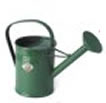 Watering Watering
Most herbs require moisture for survival; therefore, in very dry areas where there is insufficient rainfall, some form of permanent irrigation may be necessary, especially during the establishment phase. At later stages, a simple garden hose or watering can may be used.
 Container Gardening Container Gardening
Don't think that you can't grow herbs just because you don't have a big plot of land suitable for a garden! Even city apartment dwellers can grow herbs in containers, whether in a sunny window or on a patio. You can plant a window box or a half whiskey barrel with your favorite cooking herbs, or keep a few small pots on a sunny windowsill. Rosemary plants live outside during the summer, and over winter can live in the kitchen window in a pot.
More Articles
Growing Seed Herbs
|


